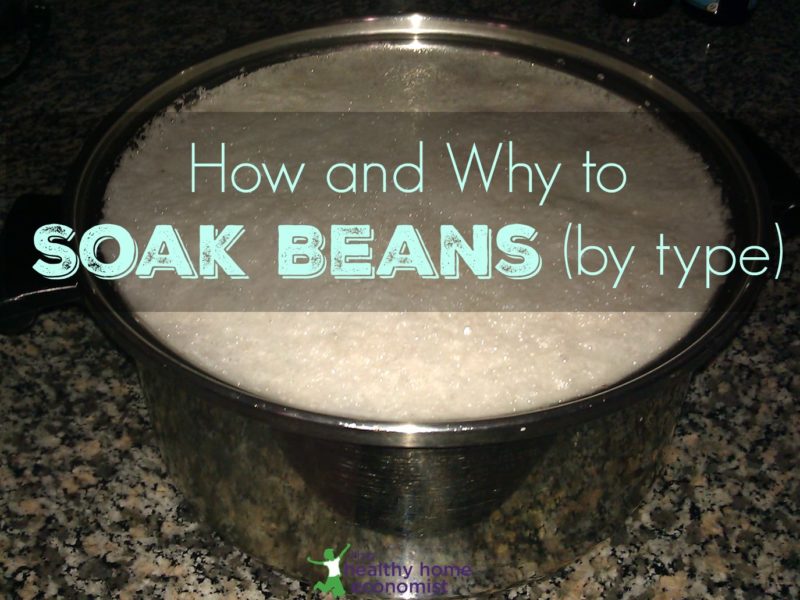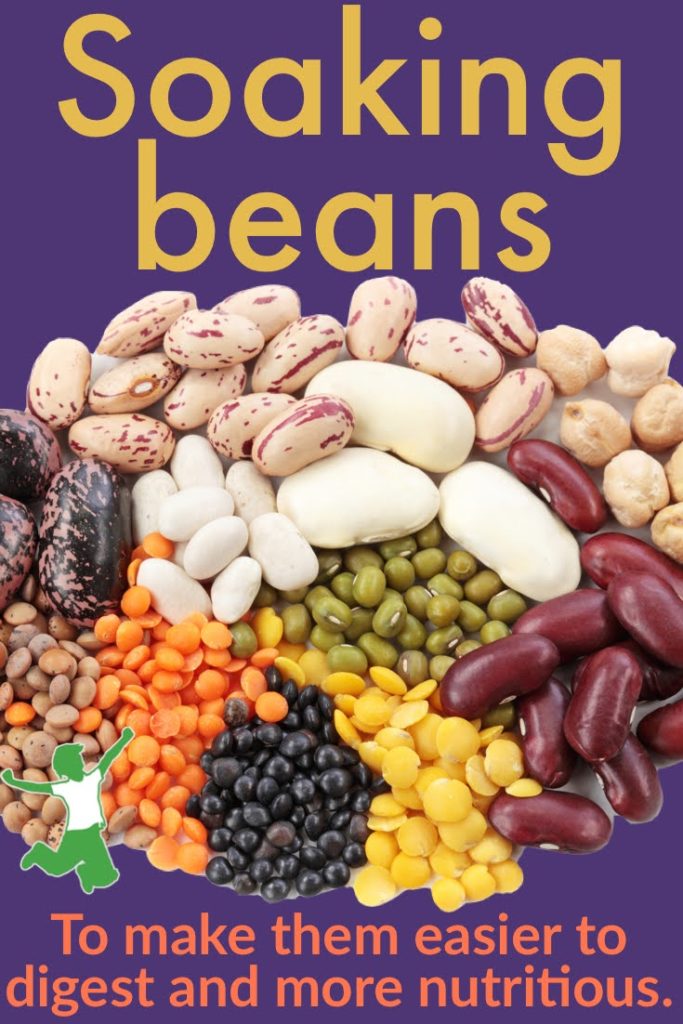Table of Contents[Hide][Show]
The simple overnight process of how to soak beans (by type) will help to eliminate gas and intestinal issues so you can enjoy eating these nutritious plant foods again!

I went on a bean soaking binge this past weekend, and the amount of scum that came to the top of the large pot of soaking kidney beans was so huge, I thought it deserved its own blog post. Soaking beans for many hours before cooking them produces a lot of scum which is course, is rinsed and drained away when the soaking is complete.
What is all that scum anyway? Anti-nutrients, that’s what! And those anti-nutrients such as phytic acid, lectins, and enzyme inhibitors are going to be in your gut causing you gas, heartburn, reflux, and whatever other digestive ills beset you when you eat something that isn’t particularly digestible unless you soak your beans before cooking them.
Traditional cultures took great care to prepare their legumes with a long soak before cooking to enhance digestibility and nutrient absorption.
I love Mexican food but really try to avoid Mexican restaurants for this reason .. they don’t soak their beans before cooking them!
After a meal at a Mexican restaurant, I will typically feel very bloated. Eating the same meal prepared at home where I soaked the beans properly before cooking results in no digestive upset whatsoever.
Take the Soaked Beans Challenge!
If you think unsoaked beans don’t cause you any trouble .. take this challenge. Soak beans next time before cooking and notice the difference in your stomach after eating.
You may think that the unsoaked beans don’t cause you any trouble, but you just may find that soaked beans are infinitely more filling and that you eat less and enjoy the meal more as a result!
Traditional peoples were very wise in the preparation of their foods. They not only selected nutritious foods but they prepared them for maximum digestibility and nutrition.
What good is eating nutritious legumes if the body is so whacked by the anti-nutrients that it can’t very easily extract and digest the nutrition?
So, the next time you make your beans, make sure you soak them first!
I soak large pots of various types of beans every month or so and then cook them – freezing for easy, quick meals when beans are required like homemade chili.
**If you absolutely do not have time to do this, at least buy pre-soaked legumes and beans packed in glass jars. Your digestion will thank you!
How To Prepare Beans by Soaking (video tutorial)
If you’ve never soaked beans before, it’s so easy. It’s a very similar process to soaking nuts. The method also mimics the wisdom of traditional societies that soaked seeds.
See this short video below that demonstrates the simple process.
Kidney shaped beans
For kidney shaped beans and dried/split peas, put a pinch of baking soda and enough water to cover in a large pot and soak uncovered for 12-24 hours. Drain, rinse and cook as usual.
Examples of kidney-shaped beans include:
- Red kidney beans
- White kidney beans (cannellini beans)
- Pinto beans
- Anasazi beans
- Black-eyed beans (black-eyed peas)
- Great Northern beans
- Lima beans
Non-kidney shaped beans (and other legumes)
For more oval-shaped beans and other legumes, soak for 12-24 hours in filtered water to cover plus 1 tablespoon of cider vinegar or lemon juice for every cup of dried beans/legumes used.
A homemade apple cider vinegar recipe or store-bought are both fine (make sure the ACV is packed in glass). Liquid whey from yogurt, kefir, or clabbered milk may also be used. Drain, rinse, and cook as usual.
Examples of non-kidney shaped beans include:
- Black beans (turtle beans)
- Navy beans
- Fava beans
- Adzuki beans
- Chickpeas
- Lentils
For maximum digestibility, it is best to rinse and refresh the filtered water and baking soda or the acidic medium once or twice during the soaking period. If you forget, no worries.
I try to always soak beans for the full 24 hours instead of just overnight. Sometimes if I get busy, I might even soak them 36 hours, but this is risky as they can get moldy sometimes if you go over 24 hours. Best to stay between 12-24 hours particularly during summer months.
How to Cook Beans After Soaking
After soaking, be sure to thoroughly drain and rinse the beans until all the scum is washed away. Then, complete the process by doing the following.
- Fill the pot of rinsed pre-soaked beans with fresh filtered water, bring to a boil, and skim away any additional foam that may come to the top at the start of the boil.
- Turn down the heat to a simmer, add 4 crushed garlic cloves, and cook until the beans are soft (about 4 hours).
- Drain beans and add to your favorite dish or let cool and freeze in large freezer bags for quick meals at a later date!
You won’t be needing over-the-counter gas meds after preparing beans the traditional way!
Should You Use the Soaking or Cooking Water?
Some alternative cooking circles advocate using the soaking or bean cooking water. Unfortunately, neither of these practices is traditional.
Using the cooked bean water or aquafaba is actually a dangerous practice. See the linked article for reasons to avoid this modern food especially during pregnancy!
Other Types of Legumes
This article plus video on soaking lentils provide additional information specifically for this legume. Because they are soaked exactly the same as all non-kidney shaped beans, it is helpful for visual learners.
Lentils were the favorite of nutritional pioneer Dr. Weston A. Price due to their very high potassium content.
Recipes Using Pre-soaked Beans and Legumes
Here are some recipes to try using soaked beans and other legumes to entice you!









I have always had a bad tummy ache after eating beans. But I tried lentils and had no problem 🙂 I keep trying, I have also found the white navy beans stayed hard and crunchy even when I cooked them all day, so I’ll try the baking soda. Does the cider vinegar need to be raw?
I never knew that anyone cooked beans without soaking them…I was taught that they always have to be soaked first! I’ve never heard of using the acid, though. I’ll do that when I soak my black beans tonight!
I did not know to add anything to the water. But we have no issues as long as I soak the beans at least 18 hours. Shorter soaking does not go well. I have also never noted that sort of scum at the top…. Hmm…must consider.
I have never had scum of any kind when I soak pinto beans. Am I doing something wrong? I’m looking at a batch right now that I soaked last night in water with lemon juice.
I soak mine, too. But this picture made me want to puke! Thanks for the reminder if I should ever think to skip this step! 🙂
I do this with peanuts, soak for 24 hours and then boil. But since you make nut butters out of peanuts, I roast them after I boil them and then grind them into nut butters… do you think this is a good technique for peanuts or no?
Nuts are treated differently .. they should be soaked in salt water according to NT. Then dry them in a warm oven to retain the rawness.
Peanuts are not nuts, they are legumes. That means they are beans, too.
Baking soda depends on your water. If you use baking soda and your water is already soft, your beans will be mush!
Hi Sarah,
I’ve been soaking beans with whey for years (usually pinto beans, and I don’t get nearly as much scum off them). Never had any problem with it until we started eating white navy beans for GAPS. But with the white navy beans, adding whey to the soak water seems to make the beans get hard and then they stay hard even if I cook them all day. The last time I made them, I left out the whey and they were great (they did soften nicely). Do you know why the whey would make the beans get hard, and is it really detrimental to leave it out? I can’t stand hard beans…
HI Sarah, it seems that kidney shaped beans even small ones like navy beans may do better with a soak in plain water with a pinch of baking soda (see Beth’s comment above on this).
i love beans and i always soak them overnight . but i didnt know that they could be put in the freezer after cooking them. that would be great if i can do that with kidney beans and garbanzo beans. sometimes, i decide last minute to make something for a meal. and then i will get a can of beans out, which i hate to do, but when i didnt plan it ahead of time, that is the only choice. it will be great just to grab a bag of cooked frozen ones! thank you.
If you had a pressure canner, you could also home-can properly soaked, cooked beans…even faster. I am considering this.
This is a TED video. It’s talks about what’s allowed in our food supply. Totally stunning and Terrible. I thought I was pretty well informed but there are surprises …unpleasant ones.
http://articles.mercola.com/sites/articles/archive/2011/06/14/why-are-there-so-many-food-allergies-now.aspx